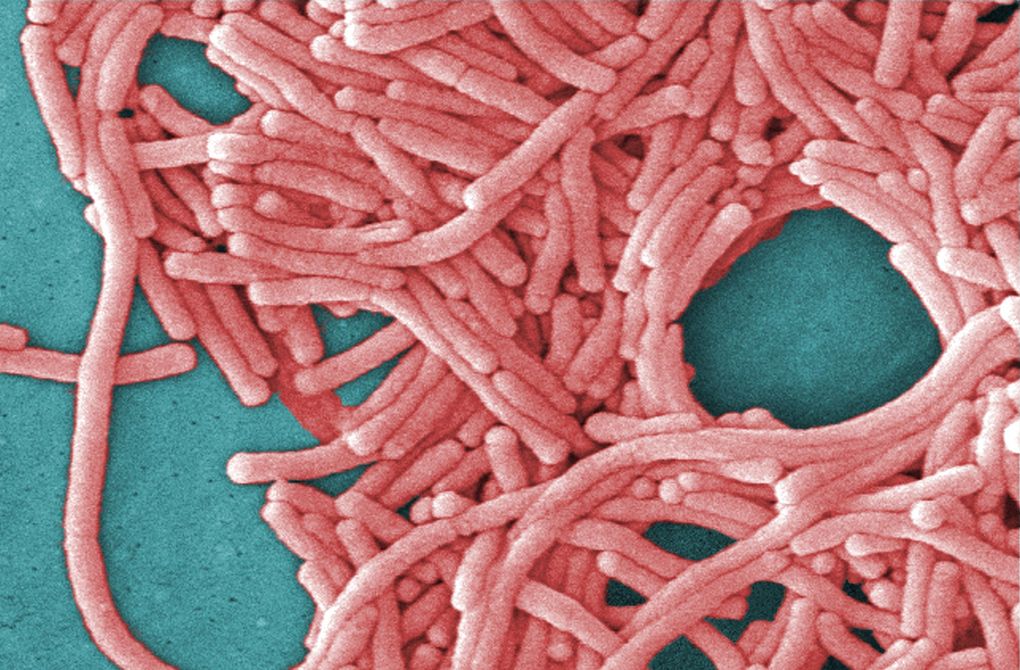UW Medical Center intensifies testing after Legionnaires’ disease death
Originally published September 13, 2016 at 4:43 pm Updated September 13, 2016 at 5:18 pm
 This undated file image made available by the Centers for Disease Control and Prevention shows a large grouping of Legionella pneumophila bacteria (Legionnaires’ disease). (Janice Haney Carr/Centers for Disease Control and Prevention via AP, File)
This undated file image made available by the Centers for Disease Control and Prevention shows a large grouping of Legionella pneumophila bacteria (Legionnaires’ disease). (Janice Haney Carr/Centers for Disease Control and Prevention via AP, File) University of Washington Medical Center has collected samples from 70 hospital sites and started testing patients for Legionnaires’ disease after two cases in the past month, including one in a man who died.
By
Seattle Times health reporter
University of Washington Medical Center (UWMC) officials are stepping up testing of the hospital environment — and patients — in the wake of two cases of Legionnaires’ disease in the past month, including one in a patient who died.
So far, officials have taken 70 separate samples from various hospital sites, including showers, scrub sinks, patient sinks, ice machine and operation-room equipment, all potential sources of the infections that cause a dangerous type of pneumonia.
They’ve also started testing patients to see if any are positive for the Legionella bacteria that cause the disease, Tina Mankowski, a hospital spokeswoman, said in an email.
UWMC has hired an independent industrial-hygiene consultant to conduct the investigation, which is being overseen by Public Health – Seattle & King County.
It follows reports of two cases of Legionella: a 30-year-old woman reported on Aug. 26 and a 50-year-old man reported on Sept. 6, health officials confirmed. The woman was discharged and is recovering at home, but the man died Thursday, King County health officials said.
Both patients were treated in the UWMC cardiac-care units. The woman could have been exposed in the hospital or in the community, but the man was at UWMC during the entire exposure window.
Results of environmental tests should be available over the next two weeks, Mankowski said. Results of patient tests will be released as available, she added.
No specific equipment has been ruled out as a source of the infection.
The Legionnaires’ cases come more than a year after UWMC was fined $54,000 by the state Department of Labor & Industries for violations that included detection of low levels of Legionella bacteria in a hospital cooling tower, a specialized device that helps heat and cool buildings year-round.
Cooling towers have been associated with outbreaks of Legionnaires’ disease, which is caused when people breathe in mist contaminated with the bacteria. It can affect the lungs, causing potentially serious disease.
There are more than 60 species of Legionella, including L. pneumophila, the type that infected both of the most recent patients, according to Dr. Meagan Kay, a King County medical epidemiologist.
But the type of Legionella detected in the L&I investigation was different, leading UWMC officials to focus the investigation on the direct environment and patients, Mankowski said.
Officials have been testing the cooling towers quarterly since January.
In January, tests showed evidence of small amounts of Legionella bacteria, 120 colony-forming units per milliliter of water. Another test in July showed 520 colony-forming units per milliliter. Hospital officials did not report the species identified.
The level of concern, at which employees require protection, is 1,000 colony-forming units per milliliter, according to federal Occupational Safety and Health Administration guidelines. Mankowski said the July reading may have taken too long to arrive at a testing site in Virginia, allowing bacteria to grow.
In addition to hospital cooling towers, hotel air-conditioning units, whirlpools and ice machines have been linked to the spread of Legionnaires’ disease, which is reported in about 5,000 people a year in the U.S., according to the Centers for Disease Control and Prevention.
In Washington state, the number of cases varies each year from fewer than 10 to more than 50. In 2014, 63 cases of Legionnaires’ disease were reported, including eight deaths, according to the state Health Department.
The disease was first identified after an outbreak in 1976 sickened many attendees at an American Legion meeting in Philadelphia.



